

CHEAP KALEIDOSCOPE DISSECTION REPORT Pictures and explanations of how inexpensive toy-store kaleidoscopes are made and how well they work.
(Click here to browse 70 topics on my main site ranging from magnetic rocket engines and more kaleidoscope pages to the strange world of lucid dreaming.)
While
many kaleidoscope affectionades lament the poor grade of instruments
available in toy stores, the fact is that they can supply
surprisingly entertaining images for very little money. An added
factor to consider is that they are designed to be as safe for young
children to use as is possible. There are no glass materials of any
kind that can break. You could run over one of these simple scopes
with a car and about the only way a child could hurt himself with the
remains would be to eat some of the small object pieces.
The one I found cost eight dollars.

The body is cardboard and all the endcaps are thin plastic that will bend until they fold without breaking. This is a two-mirror kaleidoscope that produces circular mandalas. One immediate problem is that the eyepiece endcap was covered with a black cardboard mask that had a very small viewing hole.
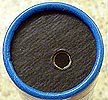
This was done because the nonreflecting surface between the two mirrors was just smooth cardboard painted black. Significant light reflected off this surface and the small hole was an attempt to limit how much of the bright and distracting outer zone was seen by the user.

The rotating end of the kaleidoscope slides over a cardboard collar glued to the outside of the main tube. At the left end of the inside of the rotating end is another small collar with plastic disks covering both ends of the collar. The space between the two disks holds the colorful plastic object pieces. When the main tube is forced all the way into the rotating tube, the collar on the main tube slides past the rolled end on the inside of the rotating tube until it is completely past it. The rolled edge then forms a catch that prevents the main tube from being pulled out. It works the same way as a fish hook: easy to push in but hard to pull out.
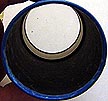
This closeup of the inside of the rotator tube shows the rolled edge that holds the two parts of the kaleidoscope together as well as the inside collar that forms the object cell. When the main tube is pushed into the rotator tube, the lengths of the collars are such that they don't quite touch, holding everything in place.
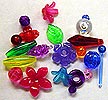
The plastic objects are of pedestrian quality for a kaleidoscope, but with bright light behind them provide pleasing images. They only fill the object cell half full, but this allows for movement and permits the observer to control the shape of the mandala. The following three images show what the manadla looks like if the scope is turned so that the "V" formed by the mirrors points down, points up, or to the side:
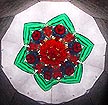
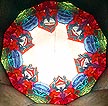
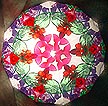
Changing the orientation of the mirrors permits the viewer to create star, ring, or full-disc mandalas.
The mirrors themselves are glued into a central cardboard tube, which is glued inside the body of the main tube. All this gluing prevented me from taking the kaleidoscope further apart. But, here's a picture of the mirrors as best as an end shot can show:

This picture was taken from the viewing end after the black cardboard disk with the small hole in it had been pulled out to make viewing through the instrument easier. Close inspection showed that the mirrors are sheets of thin polished aluminum. The low reflectivity of such surfaces can be seen when viewing a plain white field.
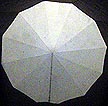
The triangular object widow is at the top. The darkening is obvious as one works his way around the mandala toward the bottom. This darkening would not be noticeable in a kaleidoscope with front surface glass mirrors. Looking at the bottom-most triangular image also shows that the final pie section isn't complete, indicating that the angle between the two mirrors isn't properly set. It appears to be too small.
While this isn't a great, or even good, kaleidoscope by artisanal standards, it does provide entertaining images for very little money. All in all I'd say it was a pretty good deal.
(Click
here to browse 70 topics on my main
site ranging from magnetic rocket engines and more kaleidoscopes
pages to the strange world of lucid dreaming.)